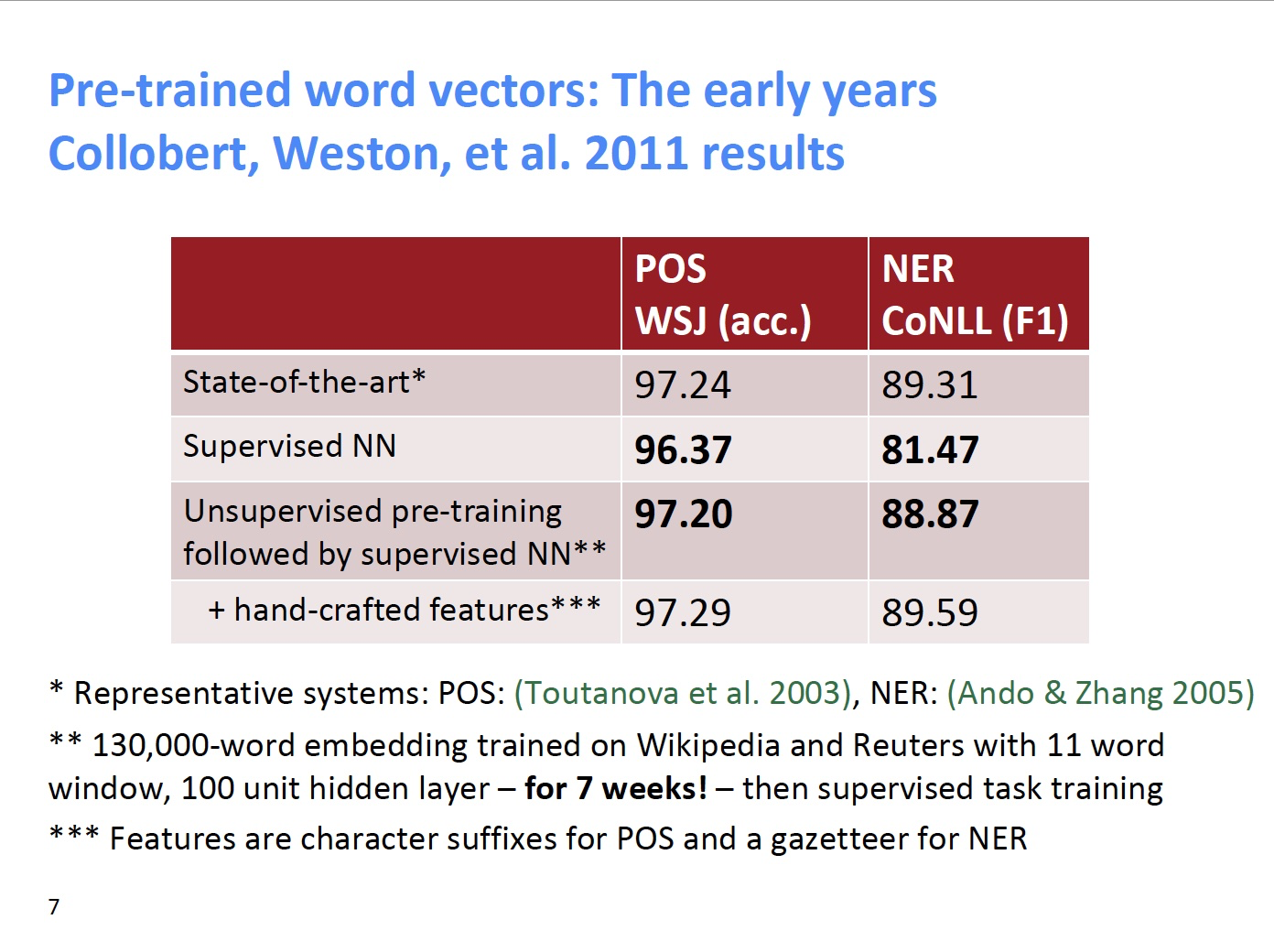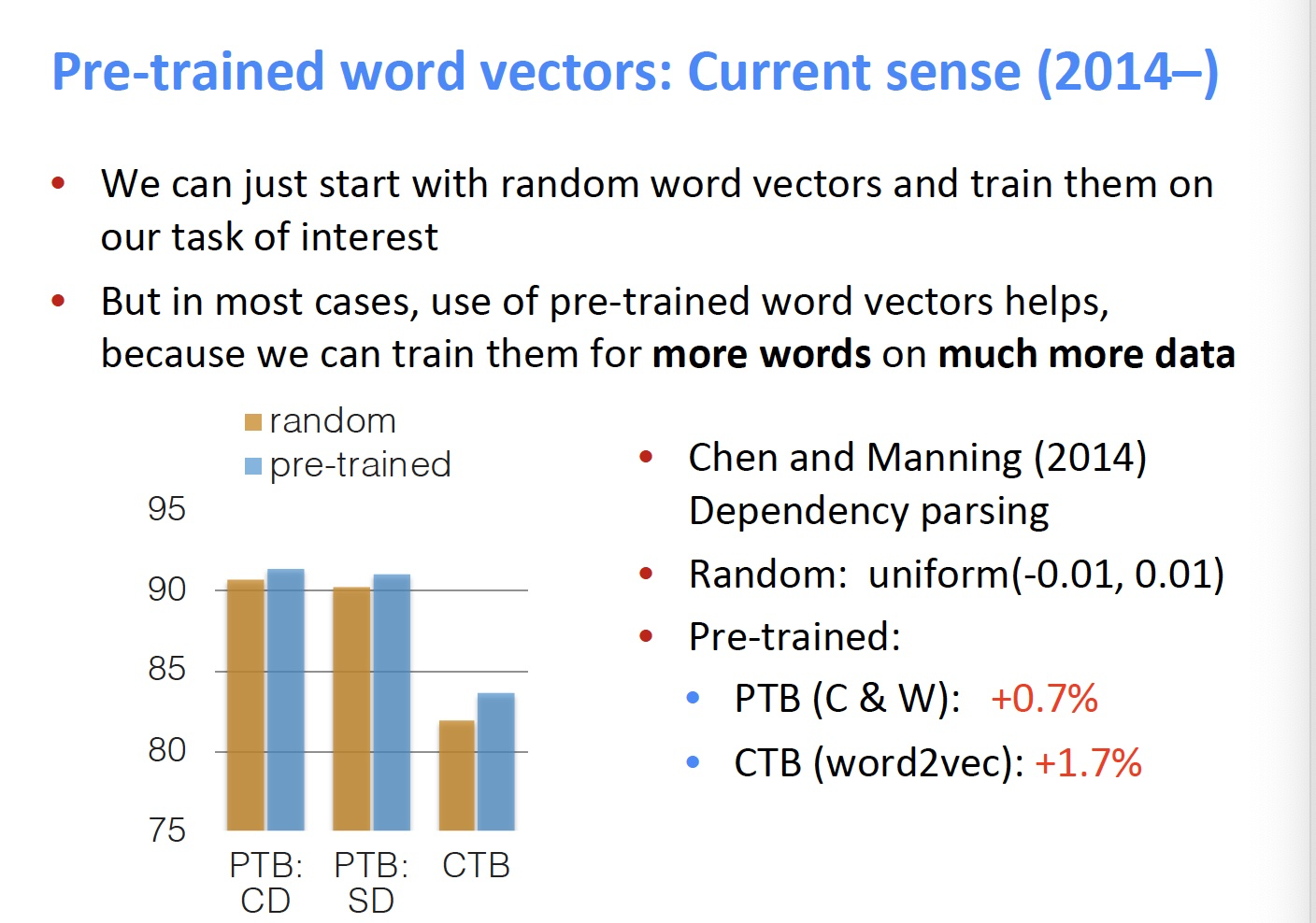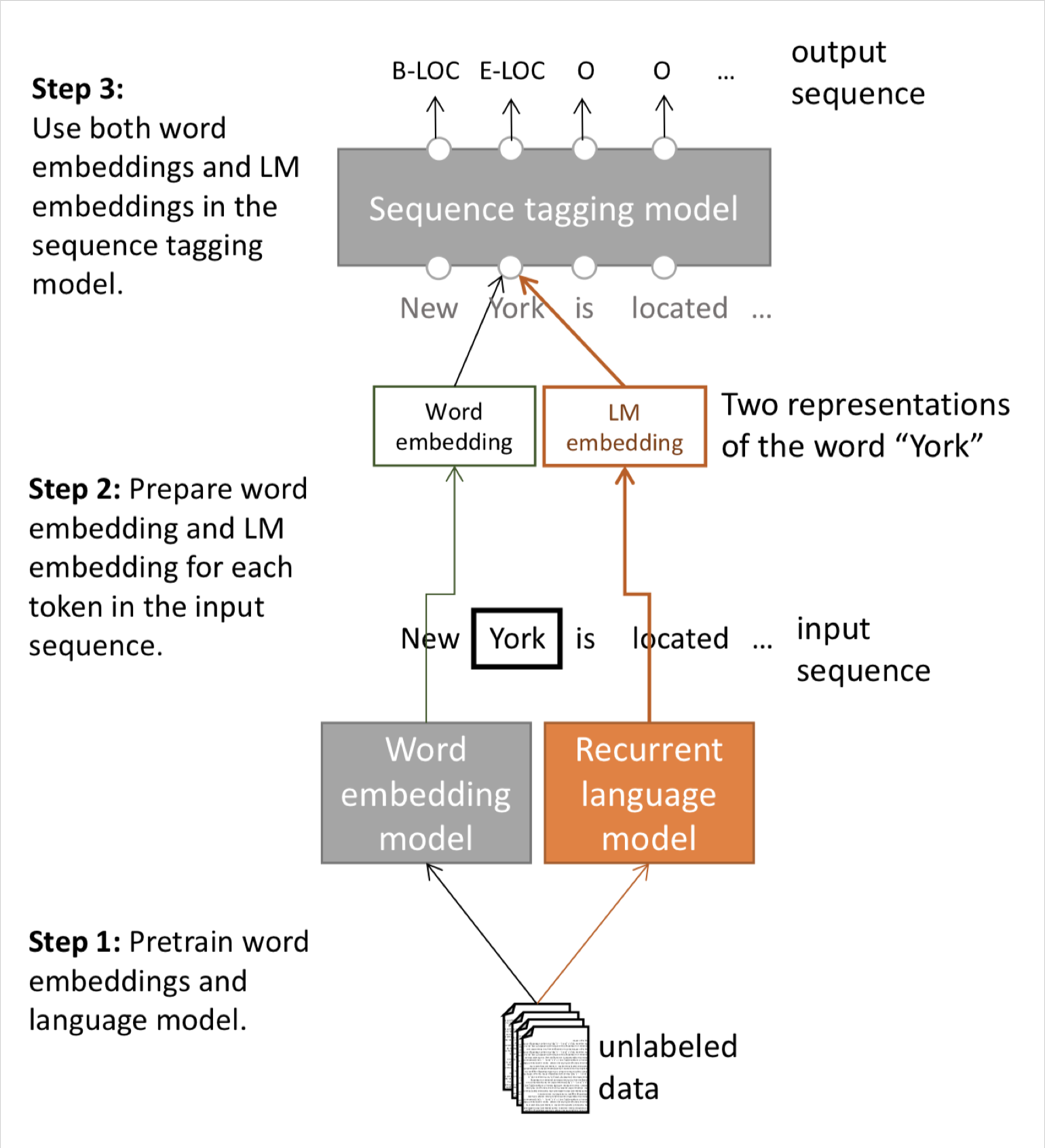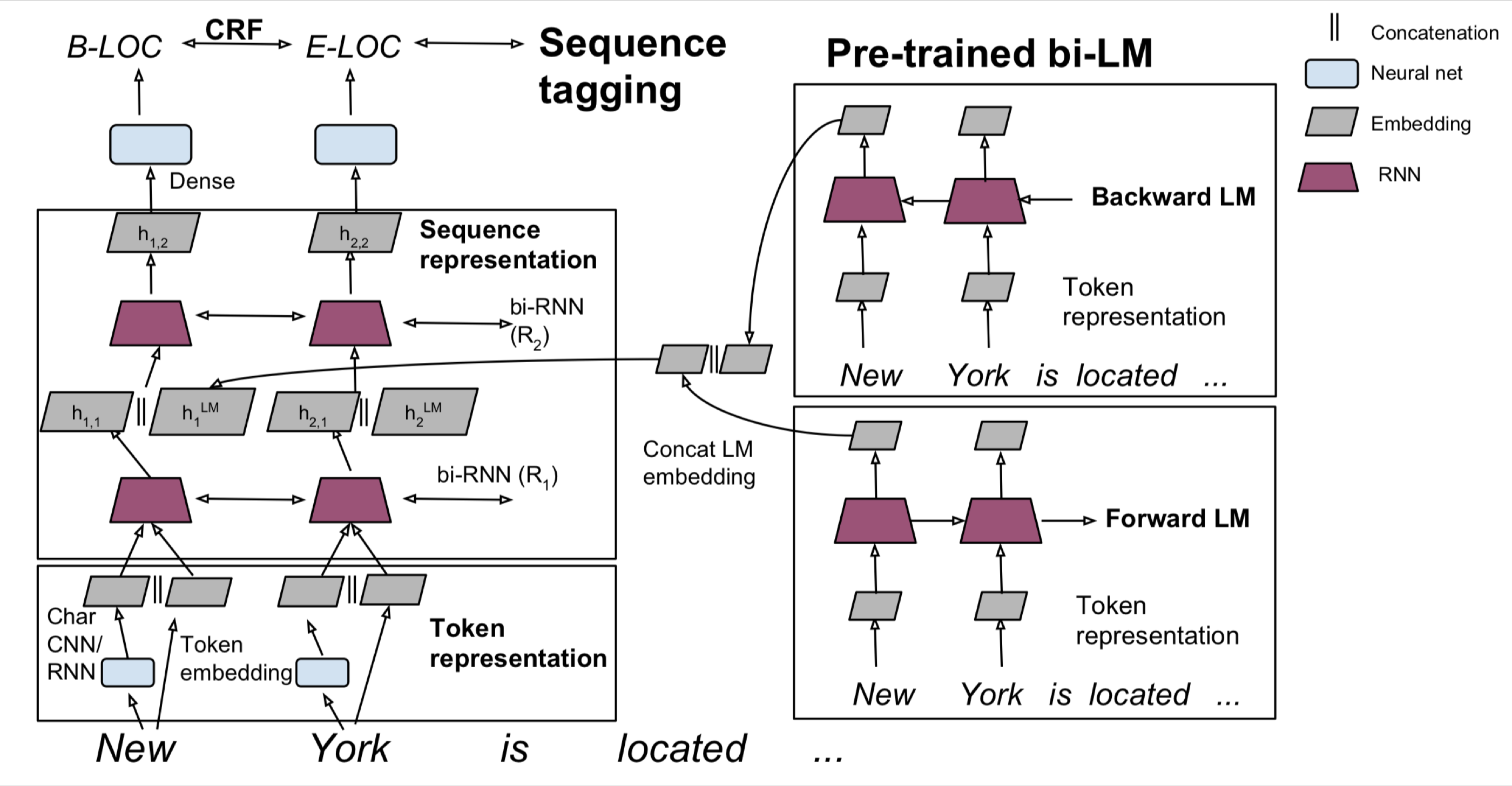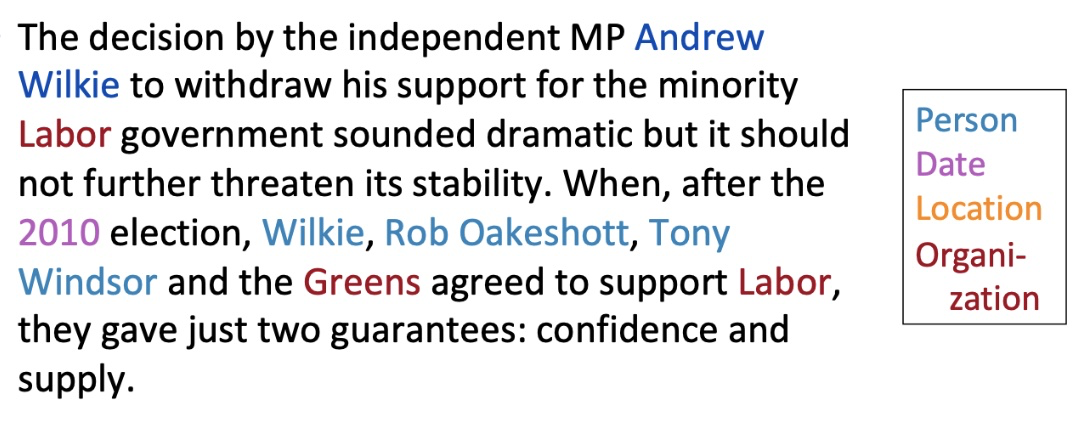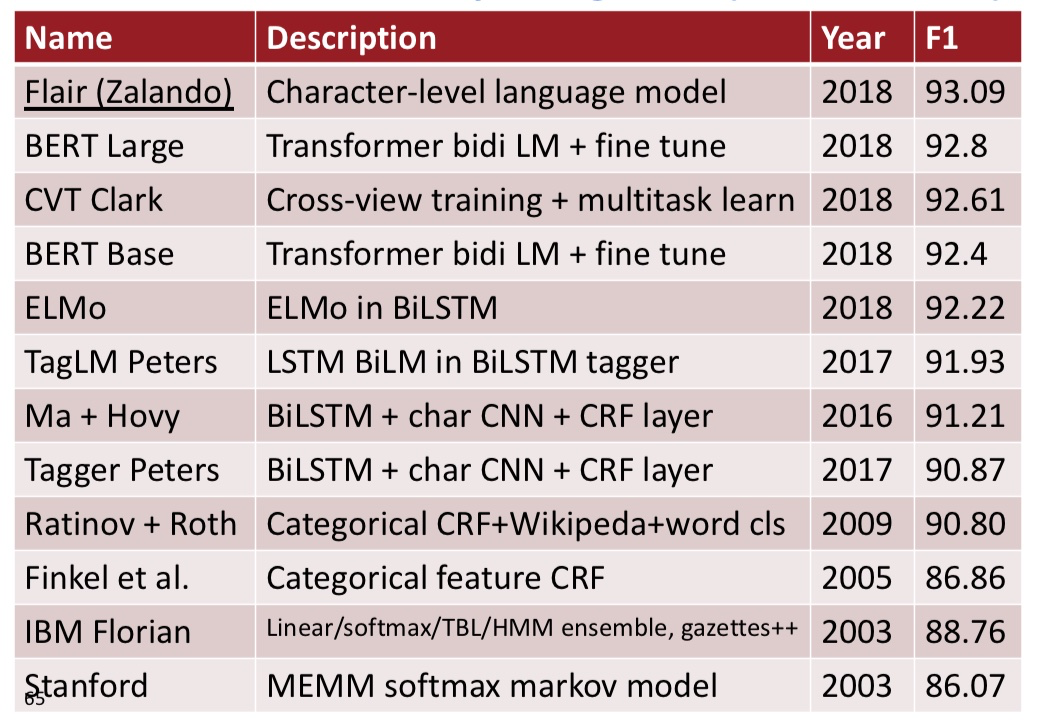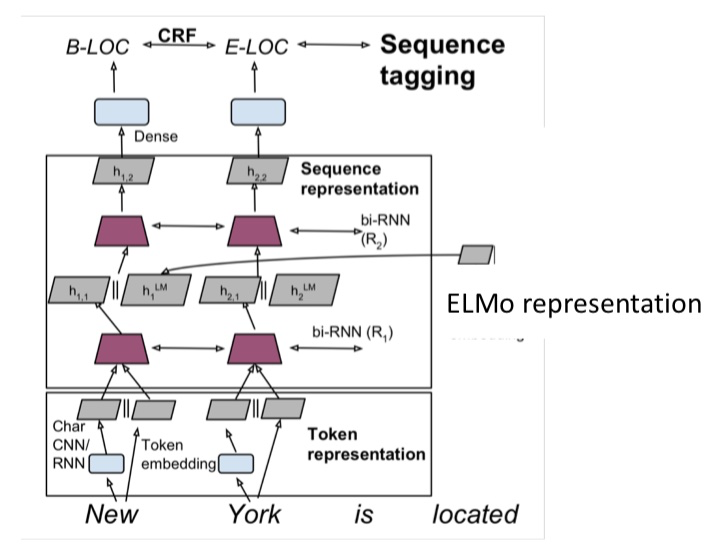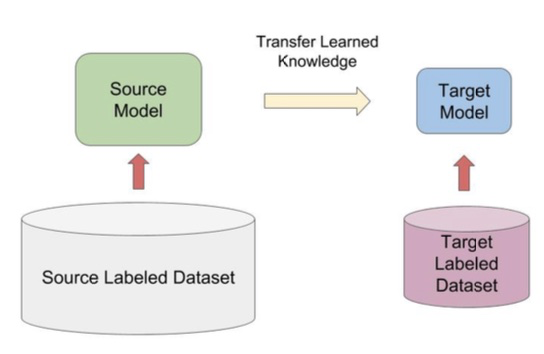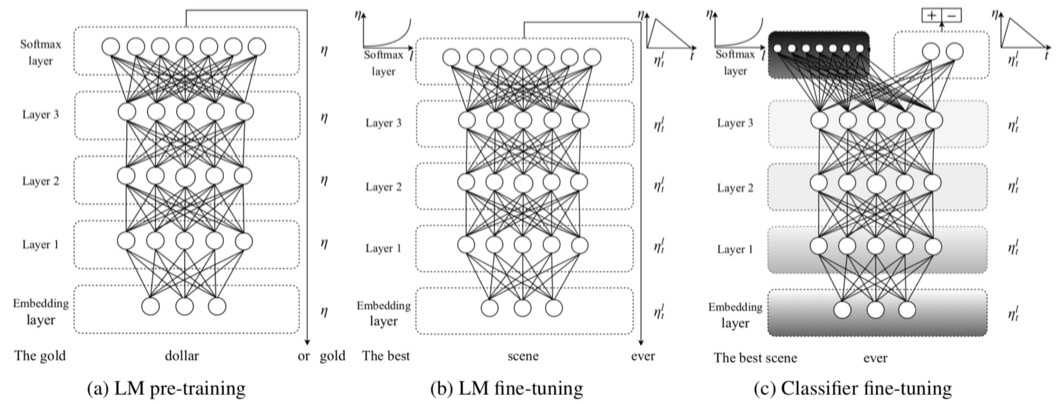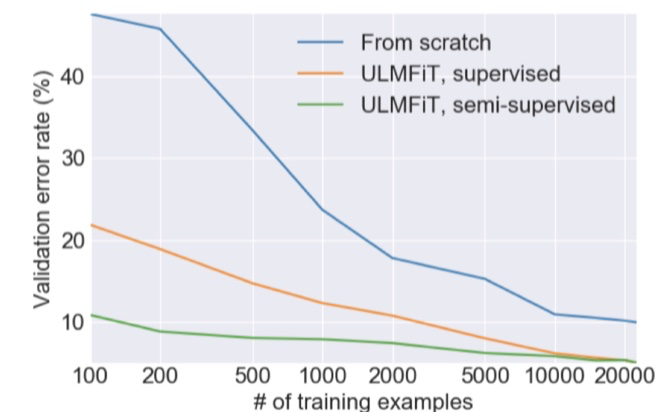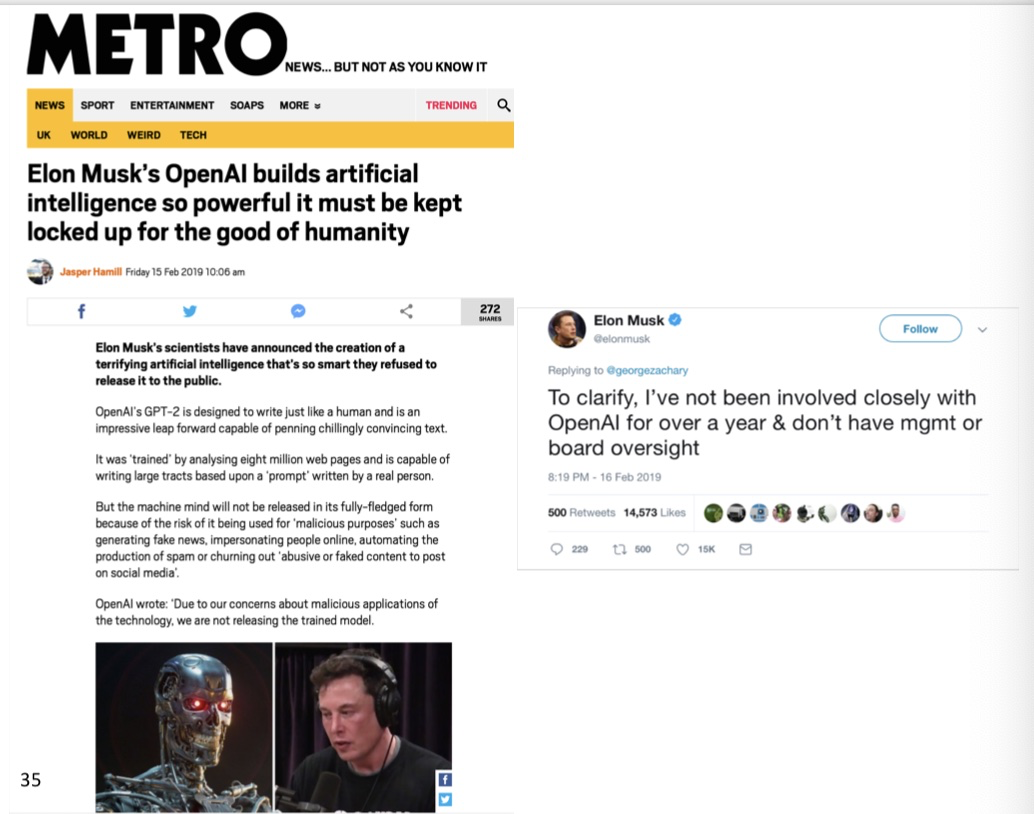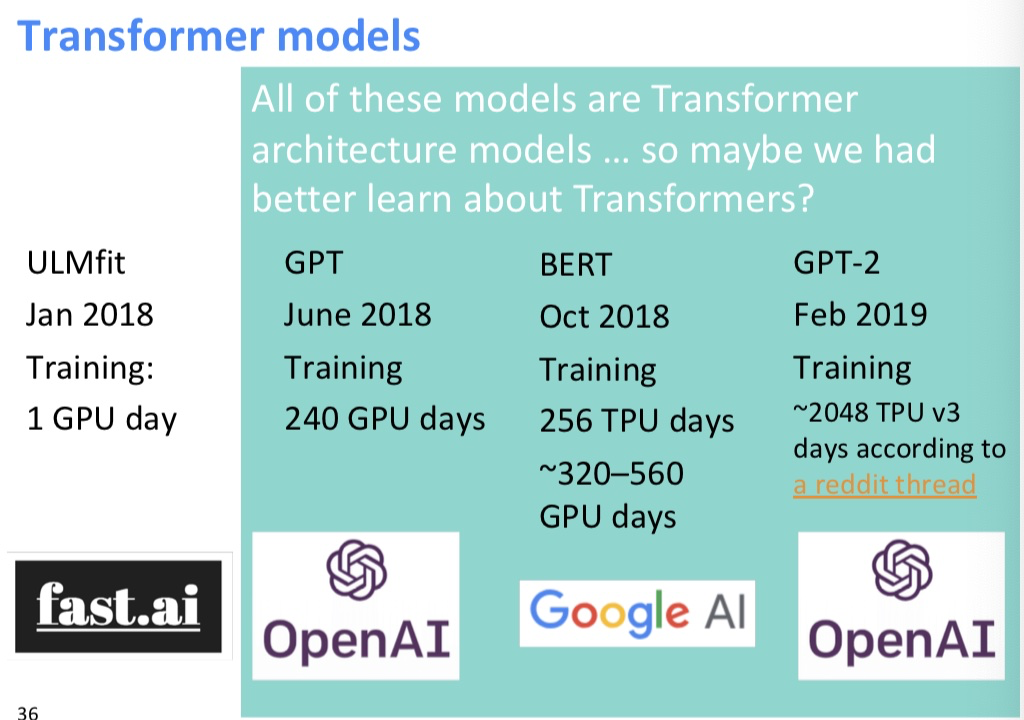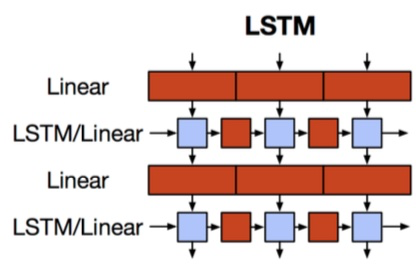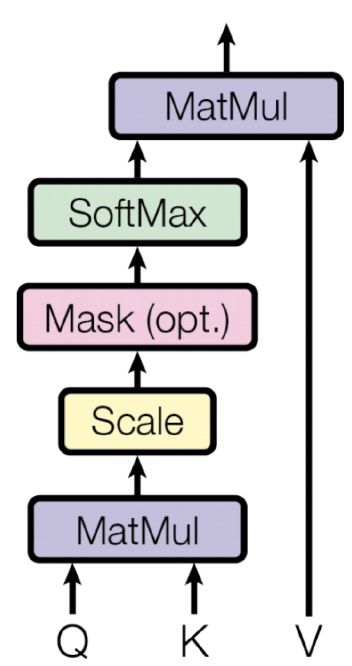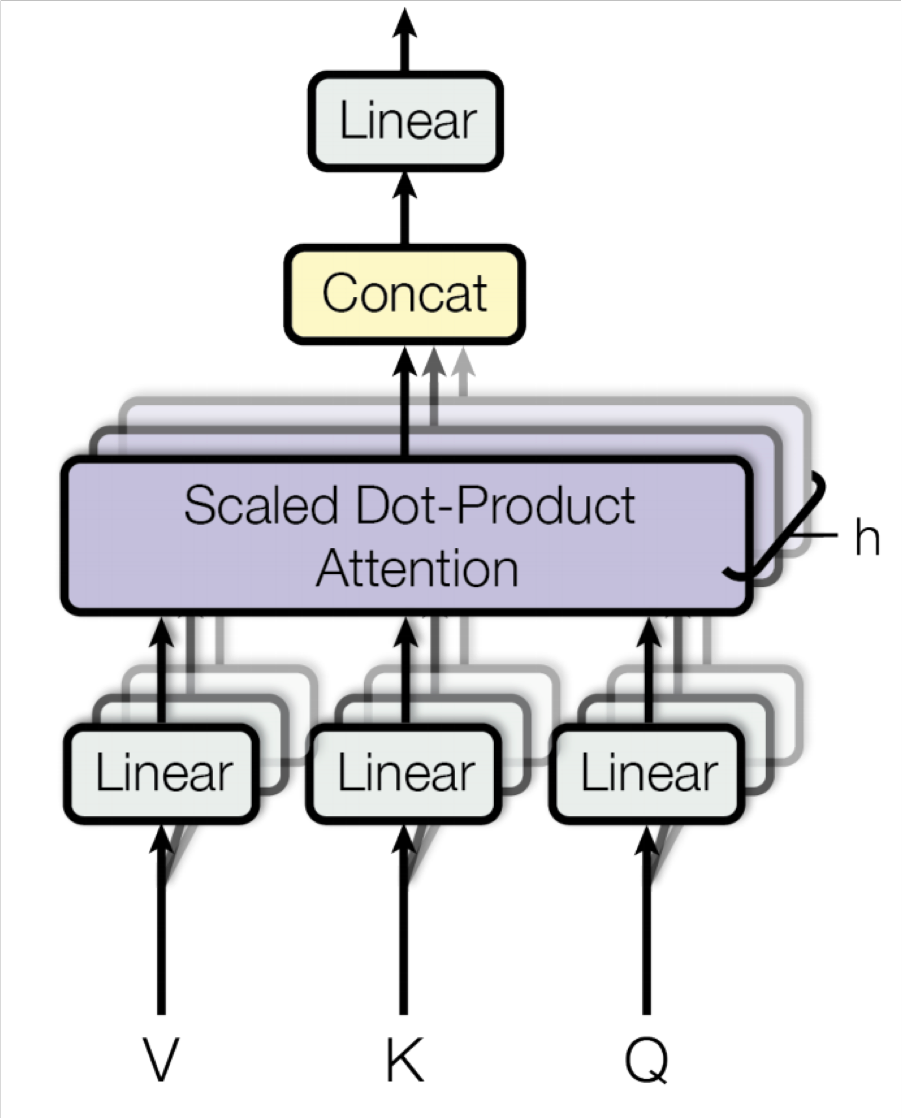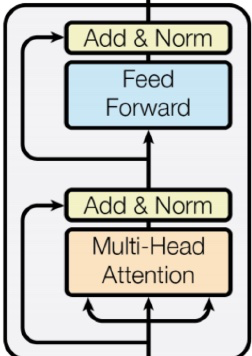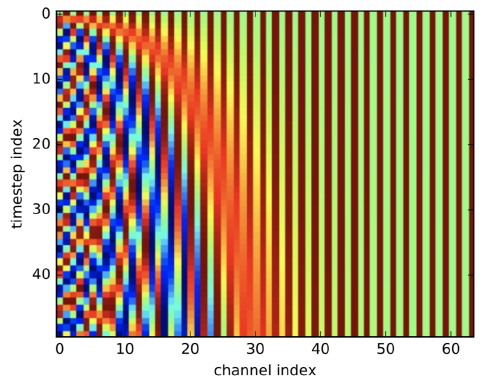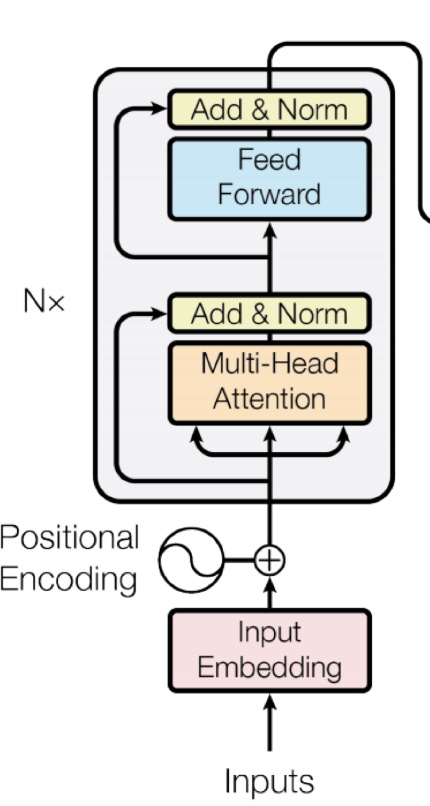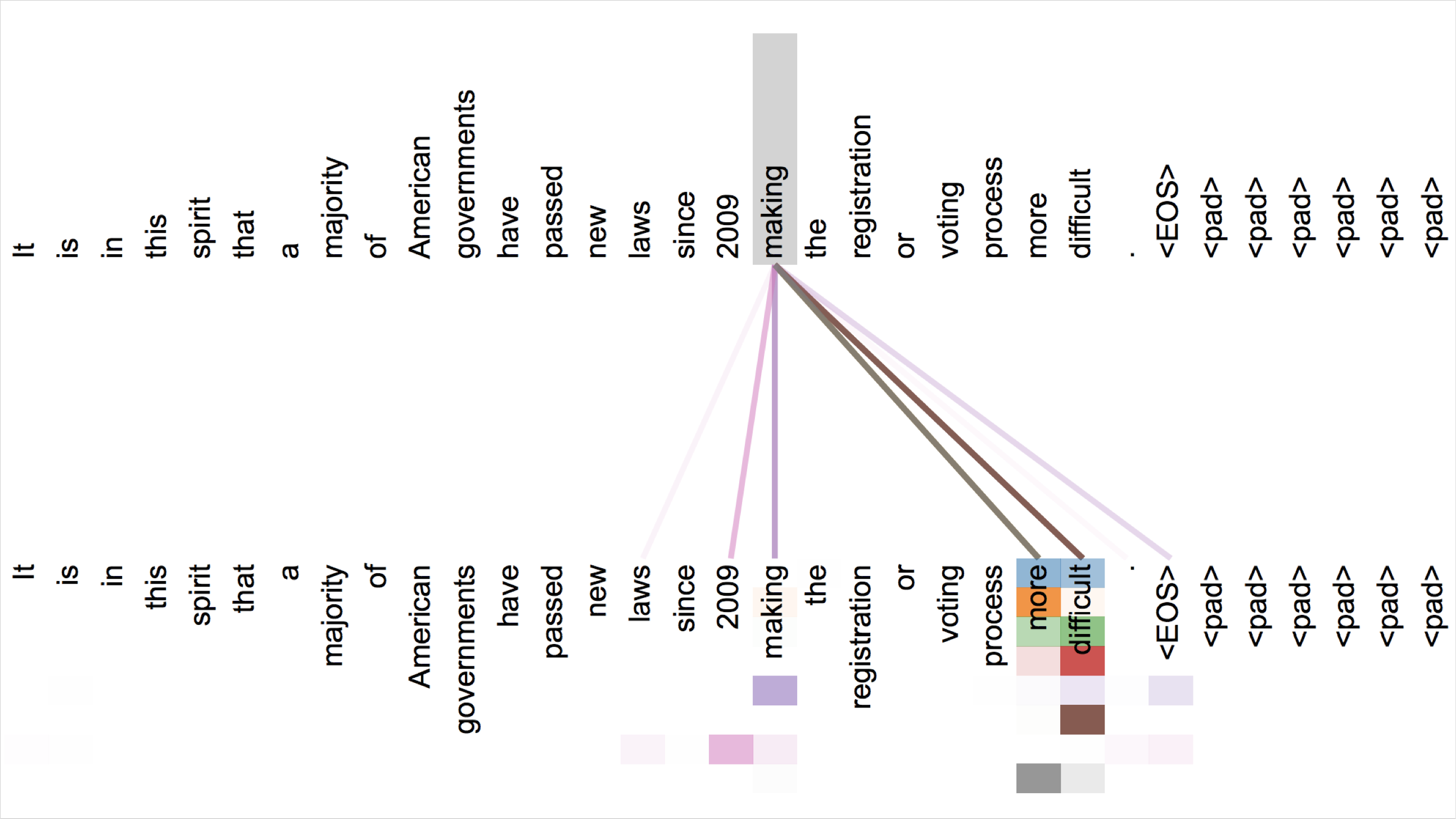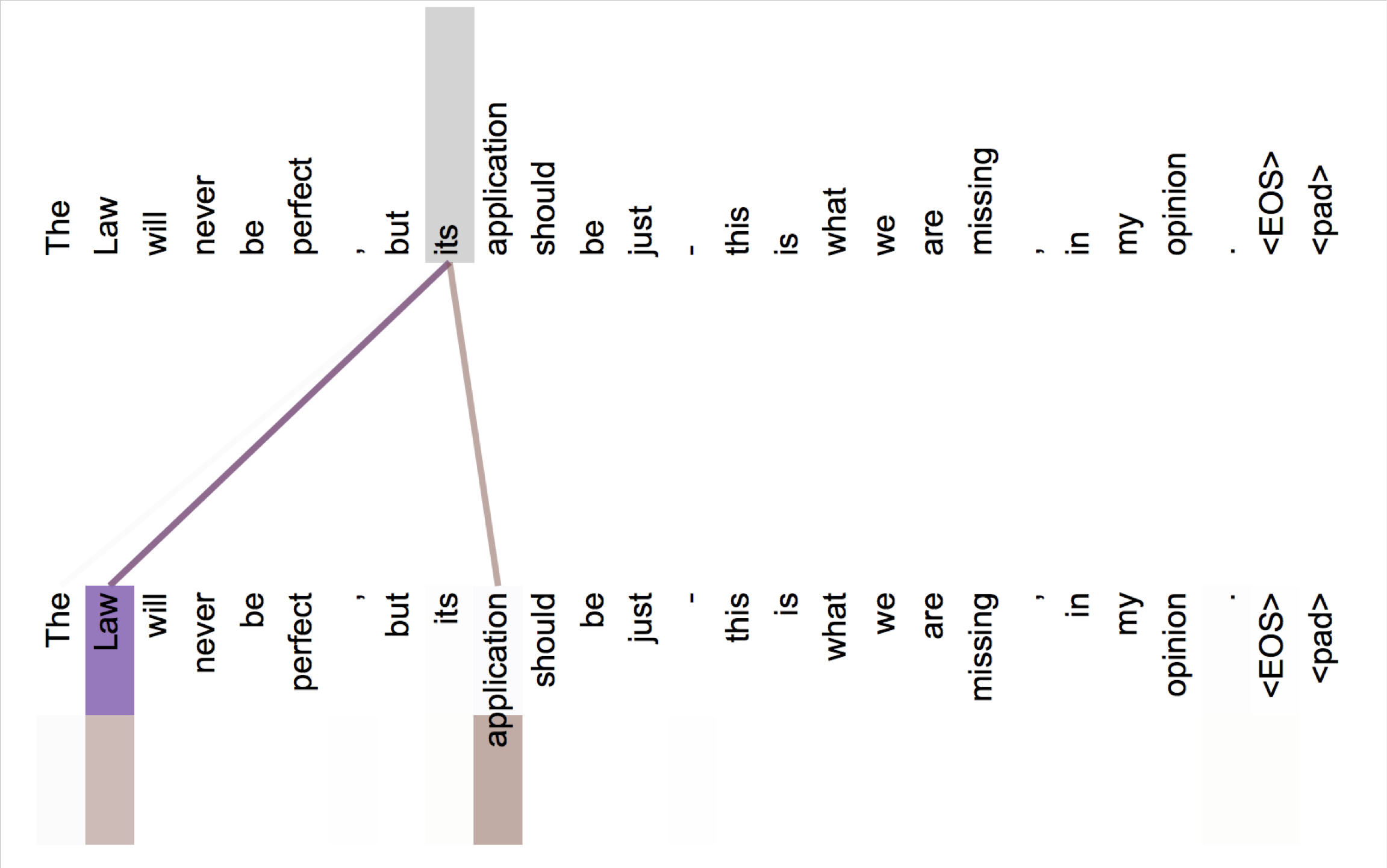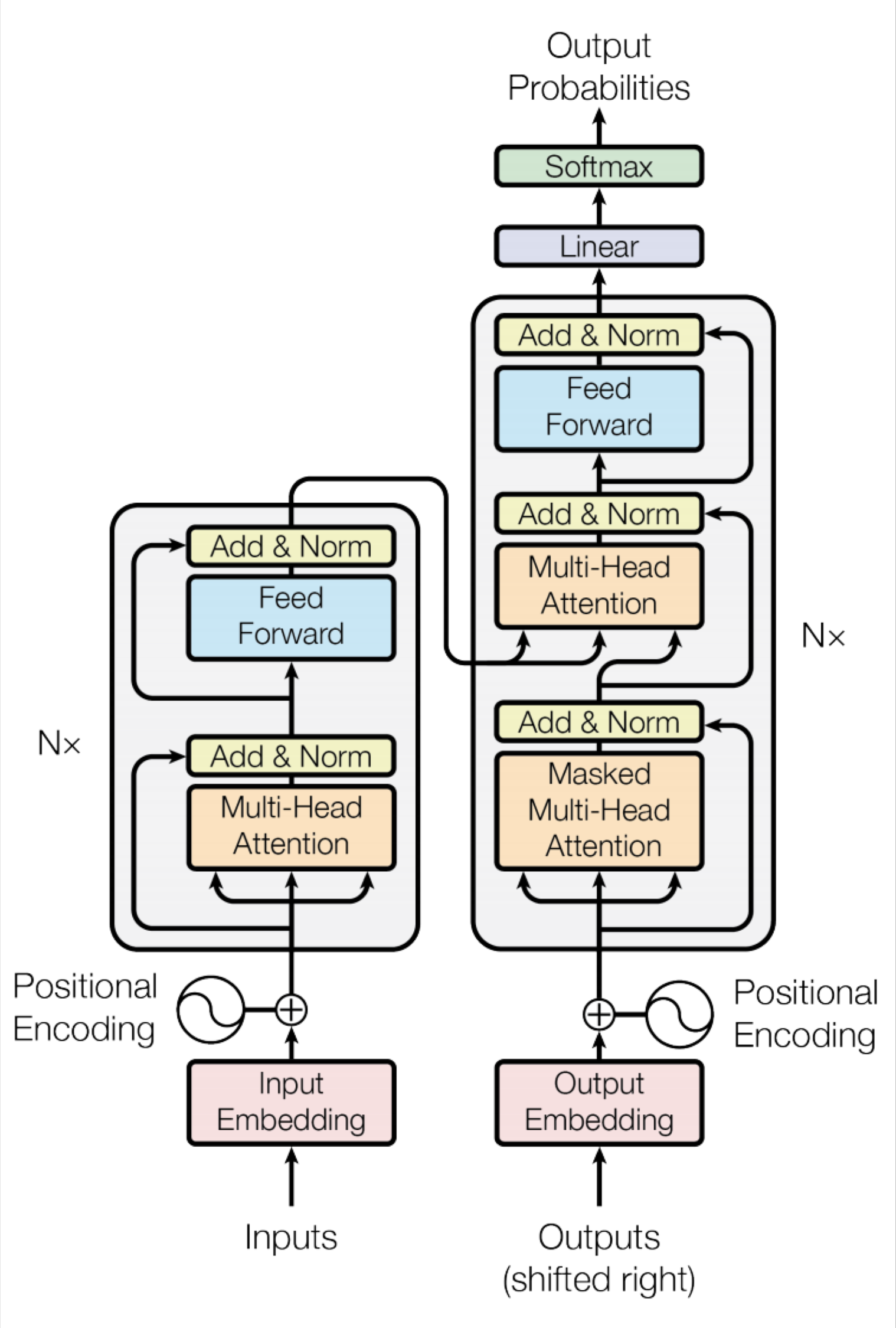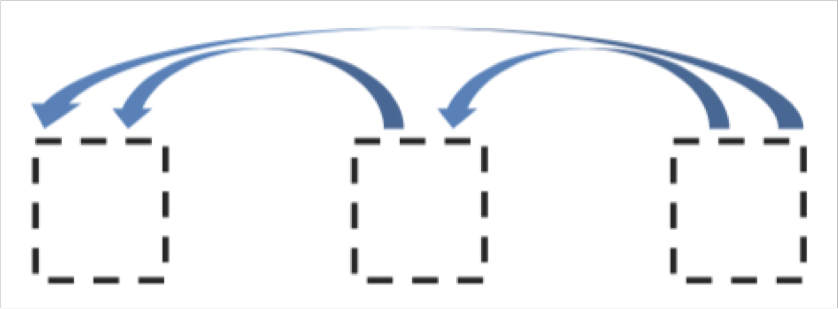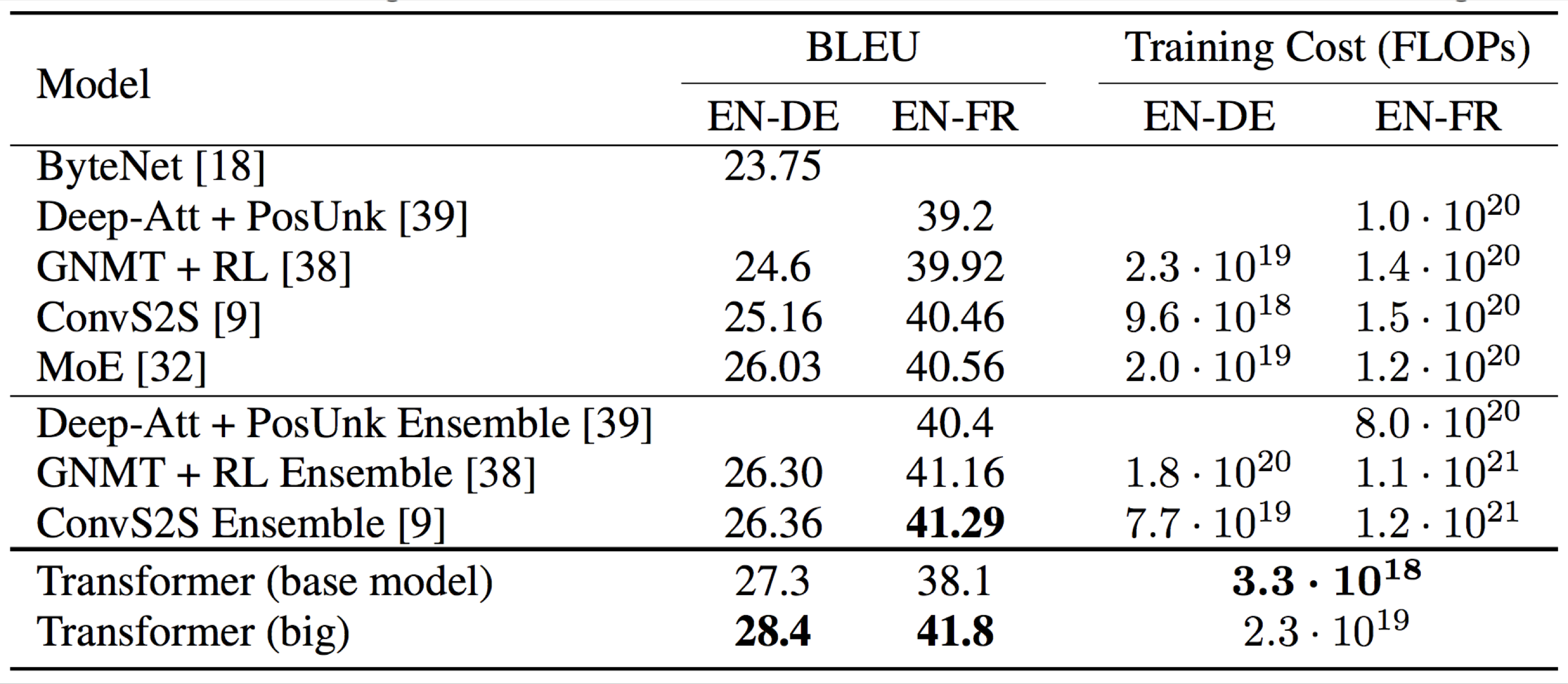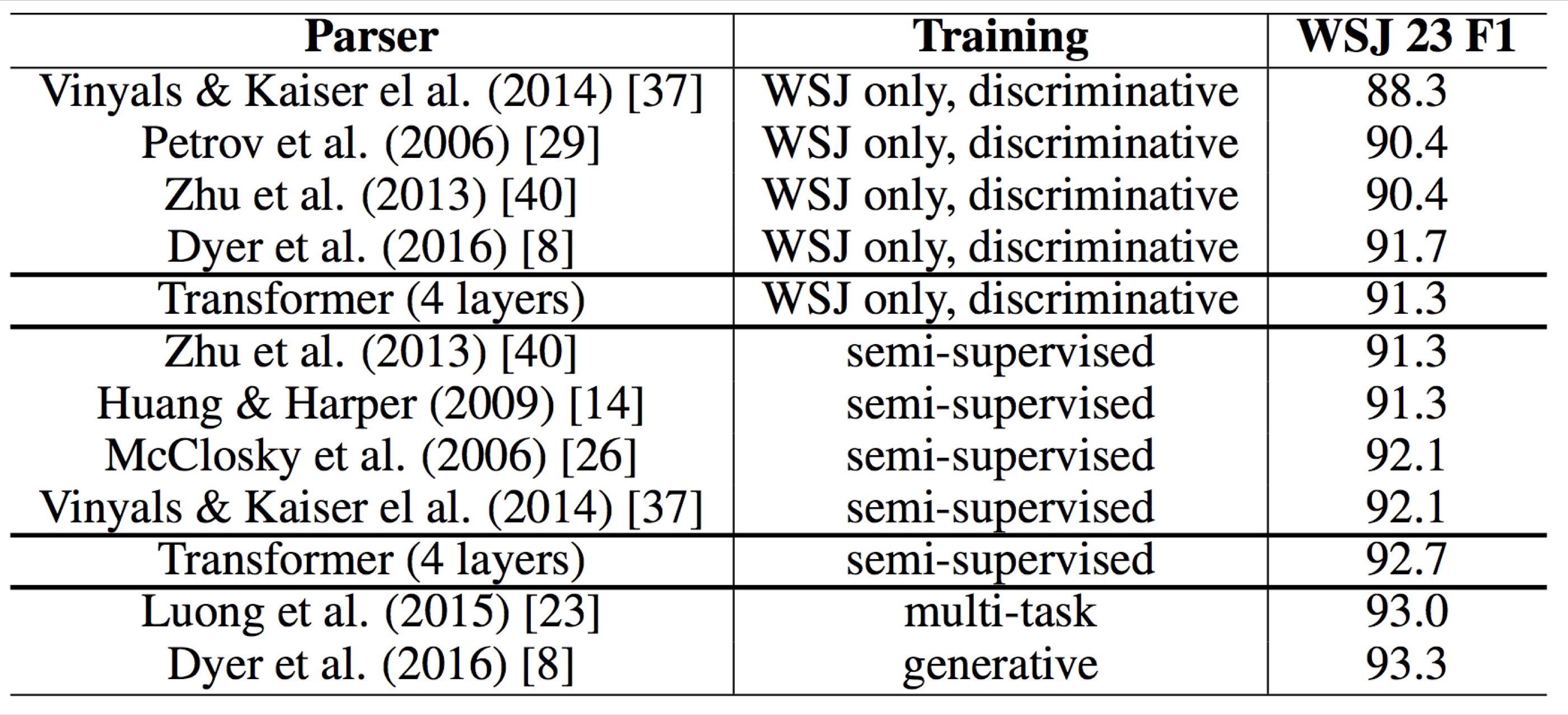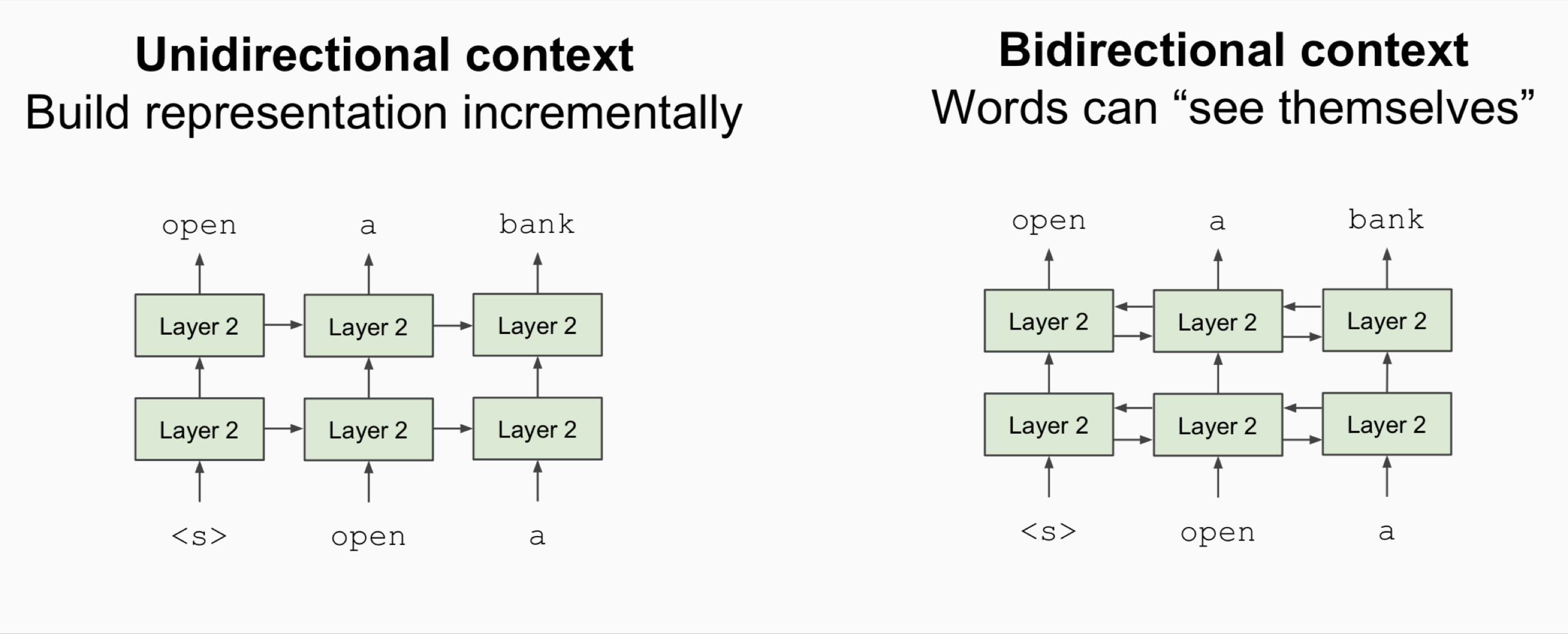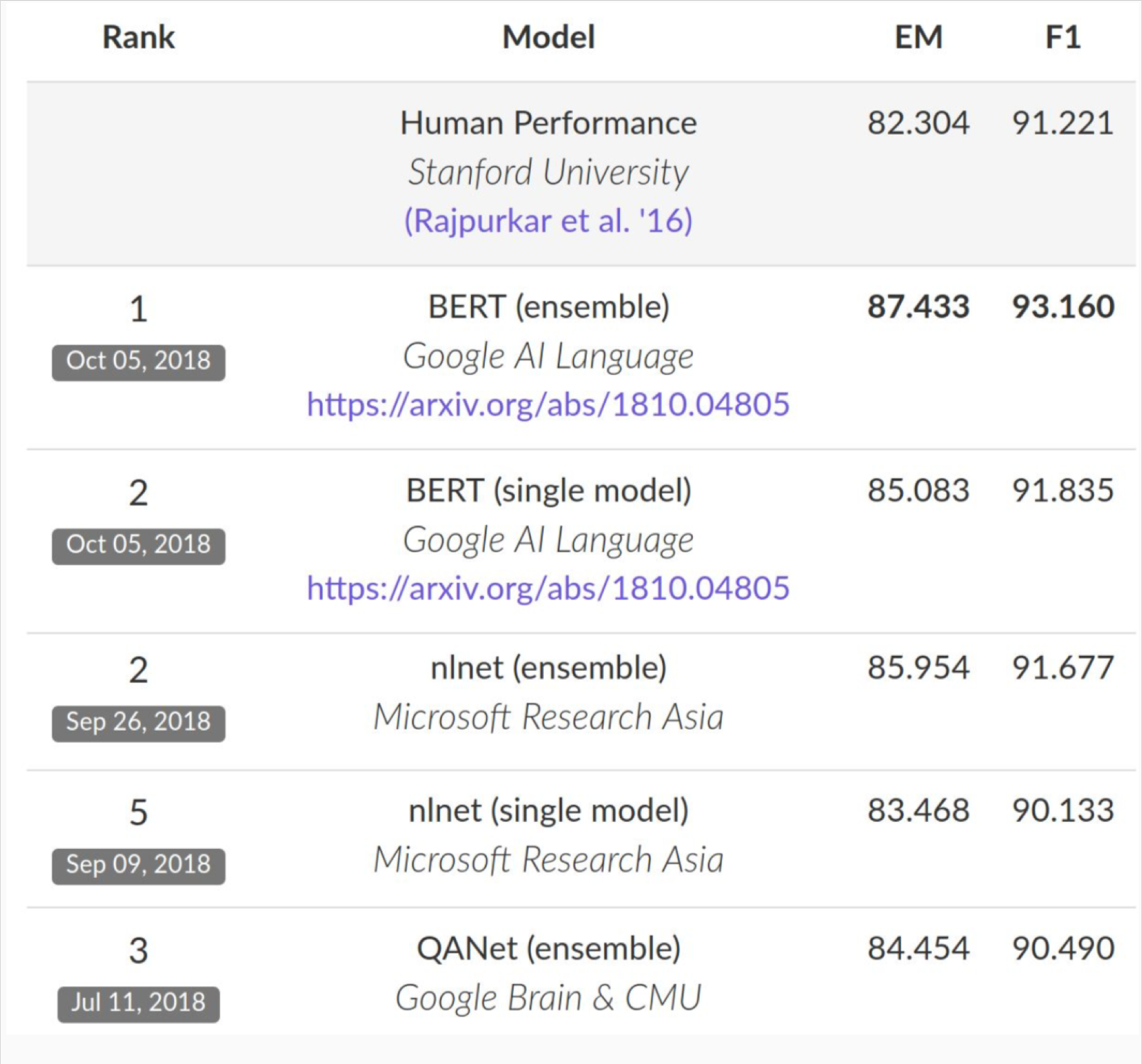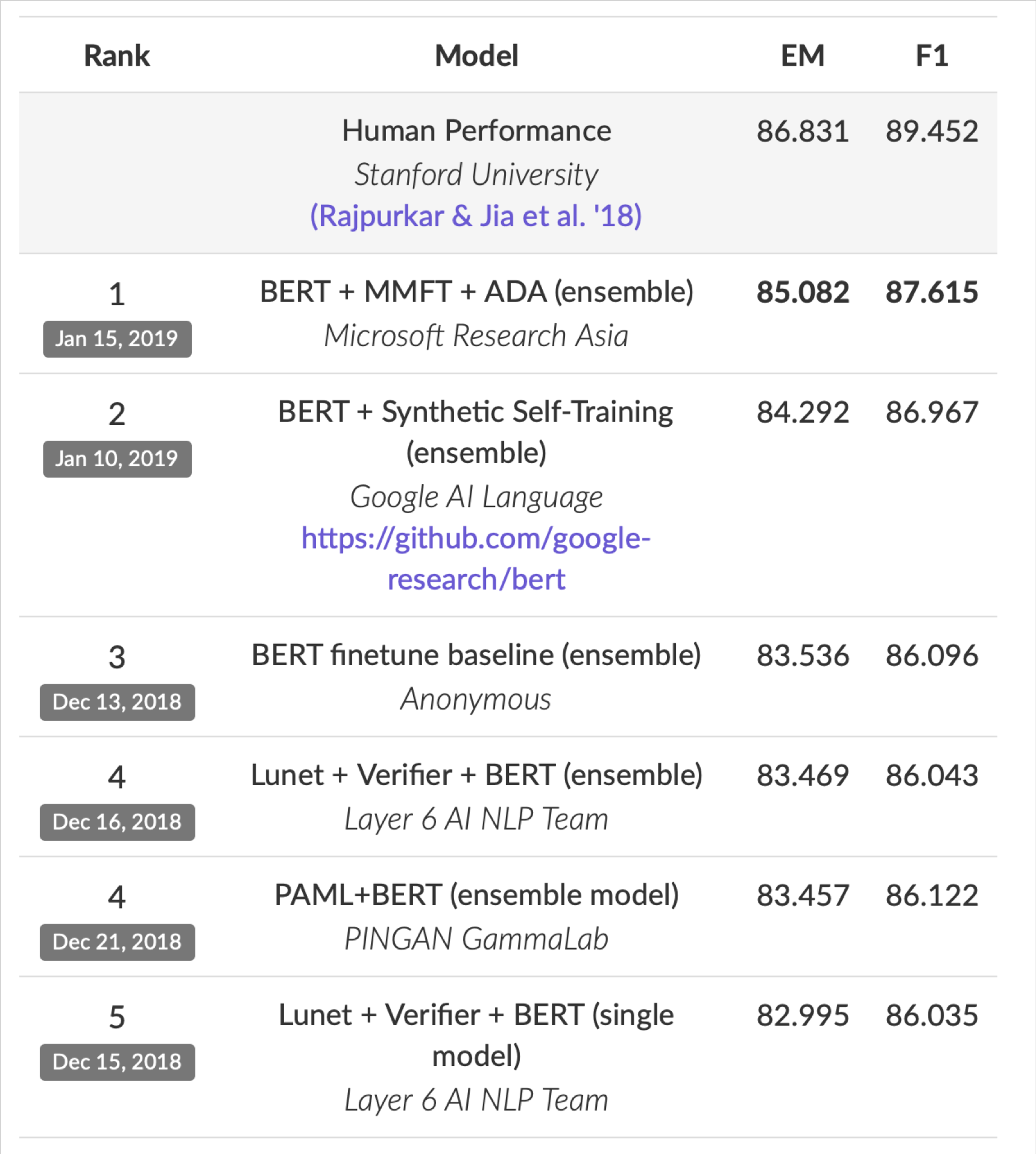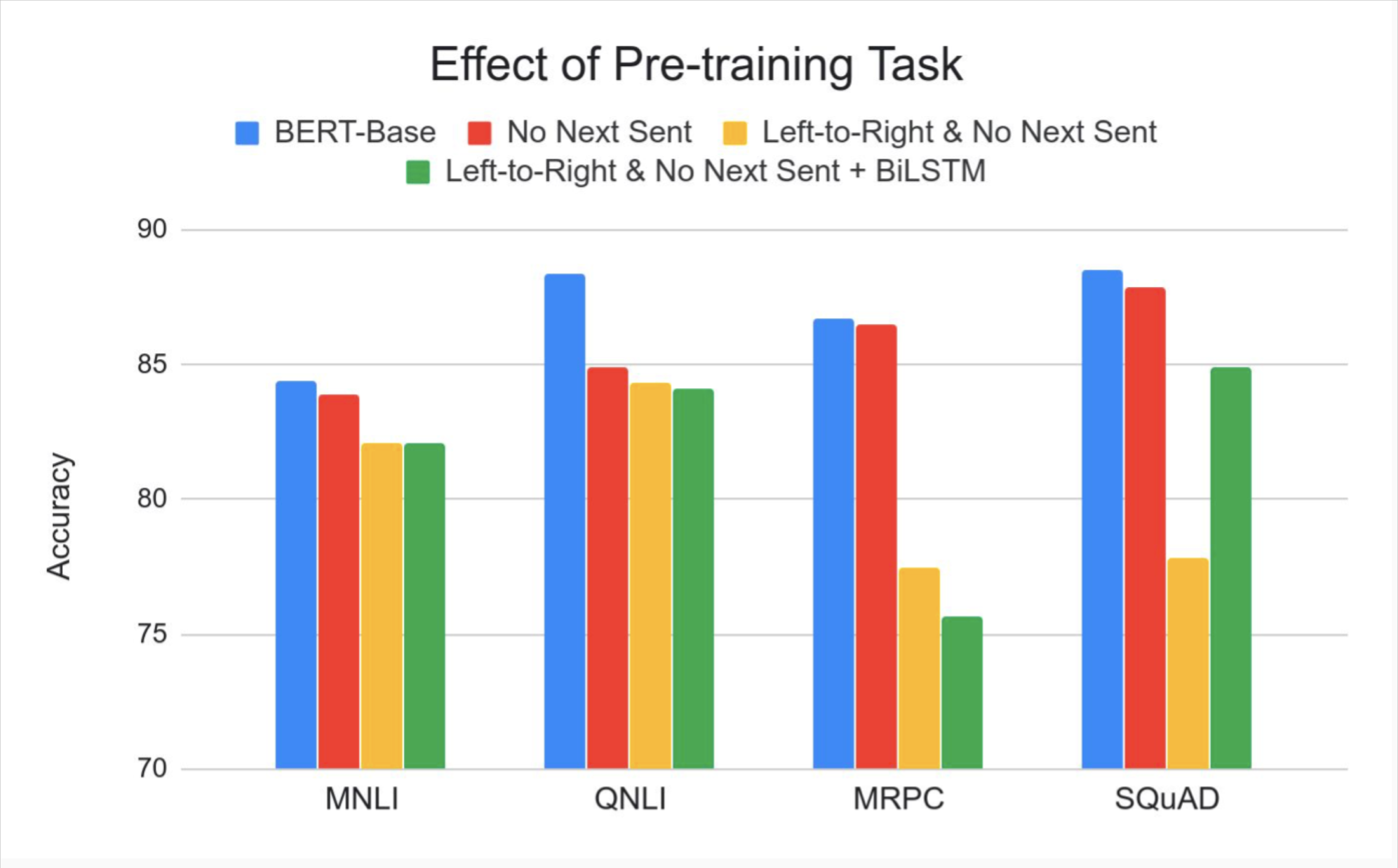13 Modeling contexts of use Contextual Representations and Pretraining
Lecture 13 Contextual Word Representations and Pretraining¶
Lecture Plan
- Reflections on word representations
- Pre-ELMo and ELMO
- ULMfit and onward
- Transformer architectures (20 mins)
- BERT
The remaining lectures
- Transformers
- BERT
- Question answering
- Text generation and summarization
- “New research, latest updates in the field”
- “Successful applications of NLP in industry today”
- “More neural architectures that are used to solve NLP problem”
- “More linguistics stuff and NLU!”
1. Representations for a word¶
现在我们可以获得一个单词的表示
- 我们开始时学过的单词向量 Word2vec, GloVe, fastText
Tips for unknown words with word vectors
- 简单且常见的解决方案
- 训练时:词汇表 Vocab 为 \(\{\text { words occurring, say, } \geq 5 \text { times }\} \cup\{<\text{UNK}>\}\)
- 将所有罕见的词(数据集中出现次数小于 5)都映射为 \(<\text{UNK}>\) ,为其训练一个词向量
- 运行时:使用 \(<\text{UNK}>\) 代替词汇表之外的词 OOV
- 问题
- 没有办法区分不同UNK话说,无论是身份还是意义
- 解决方案
- 使用字符级模型学习期词向量
- 特别是在 QA 中,match on word identity 是很重要的,即使词向量词汇表以外的单词
- Try these tips (from Dhingra, Liu, Salakhutdinov, Cohen 2017)
- 如果测试时的 \(<\text{UNK}>\) 单词不在你的词汇表中,但是出现在你使用的无监督词嵌入中,测试时直接使用这个向量
- 此外,你可以将其视为新的单词,并为其分配一个随机向量,将它们添加到你的词汇表。
- 使用字符级模型学习期词向量
- 帮助很大 或者 也许能帮点忙
- 你可以试试另一件事
- 将它们分解为词类(如未知号码,大写等等),每种都对应一个 \(<\text{UNK-class}>\)
Representations for a word
存在两个大问题
- 对于一个 word type 总是是用相同的表示,不考虑这个 word token 出现的上下文
- 比如 star 这个单词,有天文学上的含义以及娱乐圈中的含义
- 我们可以进行非常细粒度的词义消歧
- 我们对一个词只有一种表示,但是单词有不同的方面,包括语义,句法行为,以及表达 / 含义
- 表达:同样的意思可以是用多个单词表示,他们的词义是一样的
Did we all along have a solution to this problem?
- 在模型中,我们通过LSTM层(也许只在语料库上训练)
- 那些LSTM层被训练来预测下一个单词
- 但这些语言模型在每一个位置生成特定于上下文的词表示
2. Peters et al. (2017): TagLM – “Pre-ELMo”¶
Semi-supervised sequence tagging with bidirectional language models
- 想法:想要获得单词在上下文的意思,但标准的 RNN 学习任务只在 task-labeled 的小数据上(如 NER )
- 为什么不通过半监督学习的方式在大型无标签数据集上训练 NLM,而不只是词向量
Tag LM
- 与上文无关的单词嵌入 + RNN model 得到的 hidden states 作为特征输入
- Char CNN / RNN + Token Embedding 作为 bi-LSTM 的输入
- 得到的 hidden states 与 Pre-trained bi-LM(冻结的) 的 hidden states 连接起来输入到第二层的 bi-LSTM 中
Named Entity Recognition (NER)
- 一个非常重要的NLP子任务:查找和分类文本中的实体,例如
CoNLL 2003 Named Entity Recognition (en news testb)
Peters et al. (2017): TagLM – “Pre-ELMo”
语言模型在“Billion word benchmark”的8亿个训练单词上训练
语言模型观察结果
- 在监督数据集上训练的LM并不会受益
- 双向LM仅有助于 forward 过程,提升约0.2
- 具有巨大的 LM 设计(困惑度 30) 比较小的模型(困惑度 48)提升约0.3
任务特定的BiLSTM观察结果
- 仅使用LM嵌入来预测并不是很好:88.17 F1
- 远低于仅在标记数据上使用 BiLSTM 标记器
Also in the air: McCann et al. 2017: CoVe
Learned in Translation: Contextualized Word Vectors
- 也有使用训练好的序列模型为其他NLP模型提供上下文的想法
- 想法:机器翻译是为了保存意思,所以这也许是个好目标?
- 使用seq2seq + attention NMT system中的Encoder,即 2层 bi-LSTM ,作为上下文提供者
- 所得到的 CoVe 向量在各种任务上都优于 GloVe 向量
- 但是,结果并不像其他幻灯片中描述的更简单的NLM培训那么好,所以似乎被放弃了
- 也许NMT只是比语言建模更难?
- 或许有一天这个想法会回来?
Peters et al. (2018): ELMo: Embeddings from Language Models
Deep contextualized word representations. NAACL 2018.
- word token vectors or contextual word vectors 的爆发版本
- 使用长上下文而不是上下文窗口学习 word token 向量(这里,整个句子可能更长)
- 学习深度Bi-NLM,并在预测中使用它的所有层
- 训练一个双向LM
- 目标是 performant 但LM不要太大
- 使用2个biLSTM层
- (仅)使用字符CNN构建初始单词表示
- 2048 个 char n-gram filters 和 2 个 highway layers,512 维的 projection
- 4096 dim hidden/cell LSTM状态,使用 512 dim的对下一个输入的投影
- 使用残差连接
- 绑定 token 的输入和输出的参数(softmax),并将这些参数绑定到正向和反向LMs之间
- ELMo学习biLM表示的特定任务组合
- 这是一个创新,TagLM 中仅仅使用堆叠LSTM的顶层,ELMo 认为BiLSTM所有层都是有用的
- \(\gamma^{t a s k}\) 衡量ELMo对任务的总体有用性,是为特定任务学习的全局比例因子
- \(\mathbf{s}^{t a s k}\) 是 softmax 归一化的混合模型权重,是 BiLSTM 的加权平均值的权重,对不同的任务是不同的,因为不同的任务对不同层的 BiLSTM 的
Peters et al. (2018): ELMo: Use with a task
- 首先运行 biLM 获取每个单词的表示
- 然后让(无论什么)最终任务模型使用它们
- 冻结ELMo的权重,用于监督模型
- 将ELMo权重连接到特定于任务的模型中
- 细节取决于任务
- 像 TagLM 一样连接到中间层是典型的
- 可以在生产输出时提供更多的表示,例如在问答系统中
- 细节取决于任务
ELMo used in a sequence tagger
ELMo results: Great for all tasks
ELMo: Weighting of layers
- 这两个biLSTM NLM层有不同的用途/含义
- 低层更适合低级语法,例如
- 词性标注(part-of-speech tagging)、句法依赖(syntacticdependency)、NER
- 高层更适合更高级别的语义
- 情绪、Semantic role labeling 语义角色标记 、question answering、SNLI
- 低层更适合低级语法,例如
- 这似乎很有趣,但它是如何通过两层以上的网络来实现的看起来更有趣
Also around: ULMfit
Howard and Ruder (2018) Universal Language Model Fine-tuning for Text Classification.
- 转移NLM知识的一般思路是一样的
- 这里应用于文本分类
3. ULMfit¶
- 在大型通用领域的无监督语料库上使用 biLM 训练
- 在目标任务数据上调整 LM
- 对特定任务将分类器进行微调
ULMfit emphases
- 使用合理大小的“1 GPU”语言模型,并不是真的很大
- 在LM调优中要注意很多
- 不同的每层学习速度
- 倾斜三角形学习率(STLR)计划
- 学习分类器时逐步分层解冻和STLR
- 使用\(\left[h_{T}, \operatorname{maxpool}(\mathbf{h}), \operatorname{meanpool}(\mathbf{h})\right]\)进行分类
- 使用大型的预训练语言模型是一种提高性能的非常有效的方法
ULMfit performance
- 文本分类器错误率
ULMfit transfer learning
- 如果使用监督数据进行训练文本分类器,需要大量的数据才能学习好
GPT-2 language model (cherry-picked) output
- 文本生成的样例
- Transformer 不仅狠强大,而且允许扩展到更大的尺寸
4. The Motivation for Transformers¶
- 我们想要并行化,但是RNNs本质上是顺序的
- 尽管有GRUs和LSTMs, RNNs仍然需要注意机制来处理长期依赖关系——否则状态之间的 path length 路径长度 会随着序列增长
- 但如果注意力让我们进入任何一个状态……也许我们可以只用注意力而不需要RNN?
Transformer Overview
- Non-recurrent sequence-to-sequence encoder-decoder model
- 任务:平行语料库的机器翻译
- 预测每个翻译单词
- 最终成本/误差函数是 softmax 分类器基础上的标准交叉熵误差
Transformer Basics
- 自学
- 主要推荐资源
- http://nlp.seas.harvard.edu/2018/04/03/attention.html
- The Annotated Transformer by Sasha Rush
- An Jupyter Notebook using PyTorch that explains everything!
- 主要推荐资源
- 现在:我们定义 Transformer 网络的基本构建块:第一,新的注意力层
Dot-Product Attention (Extending our previous def.)
- 输入:对于一个输出而言的查询 q 和一组键-值对 k-v
- Query, keys, values, and output 都是向量
- 输出值的加权和
- 权重的每个值是由查询和相关键的内积计算结果
- Query 和 keys 有相同维数 \(d_k\) ,value 的维数为 \(d_v\)
Dot-Product Attention – Matrix notation
- 当我们有多个查询 q 时,我们将它们叠加在一个矩阵 Q 中
Scaled Dot-Product Attention
- 问题:\(d_k\) 变大时,\(q^Tk\) 的方差增大 \(\to\) 一些 softmax 中的值的方差将会变大 \(\to\) softmax 得到的是峰值 \(\to\) 因此梯度变小了
- 解决方案:通过query/key向量的长度进行缩放
Self-attention in the encoder
- 输入单词向量是queries, keys and values
- 换句话说:这个词向量自己选择彼此
- 词向量堆栈= Q = K = V
- 我们会通过解码器明白为什么我们在定义中将他们分开
Multi-head attention
- 简单self-attention的问题
- 单词只有一种相互交互的方式
- 解决方案:多头注意力
- 首先通过矩阵 W 将 Q, K, V 映射到 h = 8 的许多低维空间
- 然后应用注意力,然后连接输出,通过线性层
Complete transformer block
- 每个 block 都有两个“子层”
- 多头 attention
- 两层的前馈神经网络,使用 ReLU
这两个子层都:
- 残差连接以及层归一化
- LayerNorm(x+Sublayer(x))
- 层归一化将输入转化为均值是 0,方差是 1 ,每一层和每一个训练点(并且添加了两个参数)
Layer Normalization by Ba, Kiros and Hinton
Encoder Input
- 实际的词表示是 byte-pair 编码
- 还添加了一个 positional encoding 位置编码,相同的词语在不同的位置有不同的整体表征
Complete Encoder
- encoder 中,每个 block 都是来自前一层的 Q, K, V
- Blocks 被重复 6 次(垂直方向)
- 在每个阶段,你可以通过多头注意力看到句子中的各个地方,累积信息并将其推送到下一层。在任一方向上的序列逐步推送信息来计算感兴趣的值
- 非常善于学习语言结构
Attention visualization in layer 5
- 词语开始以合理的方式关注其他词语
- 不同的颜色对应不同的注意力头
Attention visualization: Implicit anaphora resolution
- 对于代词,注意力头学会了如何找到其指代物
- 在第五层中,从 head 5 和 6 的单词“its”中分离出来的注意力。请注意,这个词的注意力是非常鲜明的。
Transformer Decoder
- decoder 中有两个稍加改变的子层
- 对之前生成的输出进行 Masked decoder self-attention
- Encoder-Decoder Attention,queries 来自于前一个 decoder 层,keys 和 values 来自于 encoder 的输出
- Blocks 同样重复 6 次
Tips and tricks of the Transformer
细节(论文/讲座)
- Byte-pair encodings
- Checkpoint averaging
- Adam 优化器控制学习速率变化
- 训练时,在每一层添加残差之前进行 Dropout
- 标签平滑
- 带有束搜索和长度惩罚的 Auto-regressive decoding
- 因为 transformer 正在蔓延,但他们很难优化并且不像LSTMs那样开箱即用,他们还不能很好与其他任务的构件共同工作
Experimental Results for MT
Experimental Results for Parsing
5. BERT: Devlin, Chang, Lee, Toutanova (2018)¶
BERT (Bidirectional Encoder Representations from Transformers):
Pre-training of Deep Bidirectional Transformers for Language Understanding
- 问题:语言模型只使用左上下文或右上下文,但语言理解是双向的
- 为什么LMs是单向的?
- 原因1:方向性对于生成格式良好的概率分布是有必要的
- 我们不在乎这个
- 原因2:双向编码器中单词可以“看到自己”
- 解决方案:mask out k % 的输入单词,然后预测 masked words
- 不再是传统的计算生成句子的概率的语言模型,目标是填空
- 总是使用k = 15%
- Masking 太少:训练太昂贵
- Masking 太多:没有足够的上下文
- GPT 是经典的单项的语言模型
- ELMo 是双向的,但是两个模型是完全独立训练的,只是将输出连接在一起,并没有使用双向的 context
- BERT 使用 mask 的方式进行整个上下文的预测,使用了双向的上下文信息
BERT complication: Next sentence prediction
- 学习句子之间的关系,判断句子 B 是句子 A 的后一个句子还是一个随机的句子。
BERT sentence pair encoding
- token embeddings 是 word pieces (\(\text{paly}, \text{##ing}\))
- 使用学习好的分段嵌入表示每个句子
- 位置嵌入与其他 Transformer 体系结构类似
- 将以上三种 embedding 相加,作为最终输入的表示
BERT model architecture and training
- Transformer encoder(和之前的一样)
- 自注意力 \(\to\) 没有位置偏差
- 长距离上下文“机会均等”
- 每层乘法 ⇒ GPU / TPU上高效
- 在 Wikipedia + BookCorpus 上训练
- 训练两种模型尺寸
- BERT-Base: 12-layer, 768-hidden, 12-head
- BERT-Large: 24-layer, 1024-hidden, 16-head
- Trained on 4x4 or 8x8 TPU slice for 4 days
BERT model fine tuning
- 只学习一个建立在顶层的分类器,微调的每个任务
BERT results on GLUE tasks
-
GLUE benchmark 是由自然语言推理任务,还有句子相似度和情感
-
MultiNLI
-
Premise: Hills and mountains are especially sanctified in Jainism.
Hypothesis: Jainism hates nature.
Label: Contradiction
-
CoLa
-
Sentence: The wagon rumbled down the road. Label: Acceptable
-
Sentence: The car honked down the road. Label: Unacceptable
BERT results on SQuAD 1.1
SQuAD 2.0 leaderboard, 2019-02-07
Effect of pre-training task
Size matters
- 从 119M 到 340M 的参数量改善了很多
- 改进尚未渐进
Suggested Readings¶
The Annotated Transformer 代码解析
jalammar 的一系列可视化简单教程
Visualizing A Neural Machine Translation Model (Mechanics of Seq2seq Models With Attention)
Go Forth And Transform
I hope you’ve found this a useful place to start to break the ice with the major concepts of the Transformer. If you want to go deeper, I’d suggest these next steps:
- Read the Attention Is All You Need paper, the Transformer blog post (Transformer: A Novel Neural Network Architecture for Language Understanding), and the Tensor2Tensor announcement.
- Watch Łukasz Kaiser’s talk walking through the model and its details
- Play with the Jupyter Notebook provided as part of the Tensor2Tensor repo
- Explore the Tensor2Tensor repo.
Follow-up works
- Depthwise Separable Convolutions for Neural Machine Translation
- One Model To Learn Them All
- Discrete Autoencoders for Sequence Models
- Generating Wikipedia by Summarizing Long Sequences
- Image Transformer
- Training Tips for the Transformer Model
- Self-Attention with Relative Position Representations
- Fast Decoding in Sequence Models using Discrete Latent Variables
- Adafactor: Adaptive Learning Rates with Sublinear Memory Cost
The Illustrated BERT, ELMo, and co. (How NLP Cracked Transfer Learning)
Smith, Noah A. Contextual Word Representations: A Contextual Introduction.
Reference¶
以下是学习本课程时的可用参考书籍:
《基于深度学习的自然语言处理》 (车万翔老师等翻译)
以下是整理笔记的过程中参考的博客:
斯坦福CS224N深度学习自然语言处理2019冬学习笔记目录 (课件核心内容的提炼,并包含作者的见解与建议)
斯坦福大学 CS224n自然语言处理与深度学习笔记汇总 这是针对note部分的翻译
